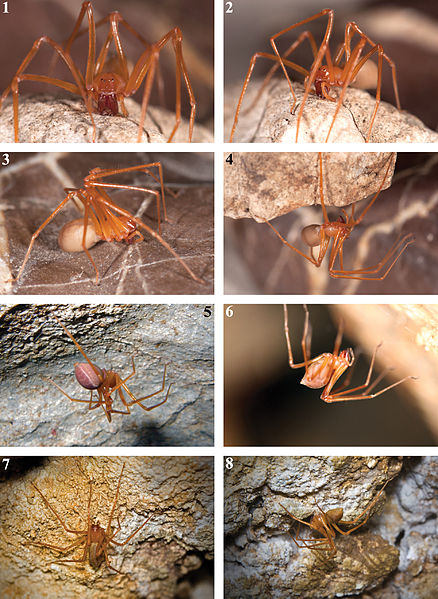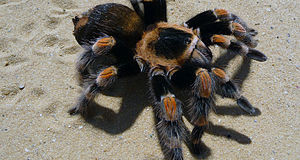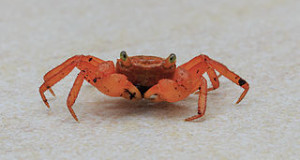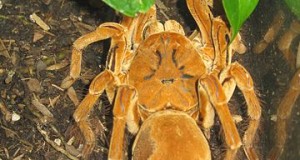Invertebrate enthusiasts have learned to expect the discovery of fantastic new species on a regular basis. But even old timers such as I were shocked by some that came to light this past year. Large, claw-bearing Cave Robber Spiders, giant bio-luminescent roaches, brilliant arboreal tarantulas, neon-colored freshwater crabs, dive-bombing wasps…the list boggles the mind. Today I’ll highlight a few that have entranced me; please post your own favorites (whether covered here or not) below.
Cave Robber Spider, Trogloraptor marchingtoni
The Cave Robber Spider, arguably 2012’s most “otherworldly” discovery, turned up in a place not known for hiding unseen species – southwestern Oregon. In fact, not a single new spider has been described in the USA in the past 130 years.
Surprisingly, the Cave Robber is not a tiny, non-descript creature likely to be missed by all but the most passionate (“obsessed”?) of arachnologists. Rather, its legs span 3 inches, the pedipalps sport bulbous, fang-like projections, and it has 8 sharp, hooked claws that have been seen on no other of the world’s other 40,000+ spiders (please see photo). Furthermore, Cave Robbers have now also been found outside of caves, in several Oregon and California old growth forests. How could such a beast have been missed!?
Possibly related to the primitive Goblin Spiders, the Cave Robber is so unique that a new family, Trogloraptoridae, has been created for it. Little is known of its natural history and, unfortunately, captives have so far refused to feed.
Dive Bombing Wasp, Kallasoma sentum
Another of my favorites also hails from a country not known as an unseen species hotspot. Discovered in Spain, the minute Dive Bombing Wasp buzzes about just above “ant head level”, looking for a victim. Upon finding a target, the wasp swoops and, in 0.052 seconds, deposits a single egg on the ant. Its larvae later use the ant as a mobile meal. Ants try to repel the airborne attacks but, as you can see from this spectacular video, they are rarely successful.
The tiny wasp’s apparent reliance on a single ant species, and habitat loss, threaten its future.
Arboreal Brazilian Tarantulas, Iridopelma, Pachistopelma and Typhochlaena spps.
Arachnologists suspect that Brazil’s Amazonian rainforests support many undiscovered tarantulas, but recently 9 new species were uncovered in the country’s semi-deciduous Atlantic Forests and Cerrado, a vast wooded savanna. These habitats were not expected to yield such an array of new spiders, all of which are boldly-marked and arboreal.
The new members of the genus Pachistopelma, the least-studied of all tarantula genera, seem to live only in plants known as Tank Bromeliads. There they ambush insects that are attracted to water that collects at the bromeliads’ bases. Among the newly-described species (genus Typhochaena) we also find the world’s smallest arboreal tarantulas. Please see the article below for natural history information and photographs.
Giant Glowing Roach, Lucihormetica luchae
This unusual insect was first described from a single specimen collected over 70 years ago. Glowing patches on the roach’s body lead predators to confuse with a toxic click beetle. While several roaches gain protection by mimicking noxious beetles (i.e. the popularly-kept Domino Roach) no others, and indeed no other terrestrial animals, do so via bioluminescence.
Unfortunately, the Giant Glowing Roach may already be extinct. It’s only known habitat was leveled when Ecuador’s Tungurahua Volcano exploded in 2010, and it has not been seen since.
Wandering Leg Sausage Millipede, Crurifarcimen vagans
The creature with this fanciful name hails from Tanzania’s Usambura Mountains, a region well known to tarantula enthusiasts and “new species hunters”. Although at 7 inches long this millipede is not the world’s largest, a very stout body and rusty-orange color renders it a most impressive beast (please see article below). Africa’s newest millipede dwells in decaying logs and has been found at 5,000+ feet above sea level.
Palawan Purple Crab, Insulamon palawanense
Freshwater crabs represent a huge evolutionary leap, and have very unusual lifestyles. I’ve kept several species, but interest in zoos and the pet trade is not high. This year, however, the discovery of 4 stunningly-beautiful freshwater crabs has drawn some attention to the group. All were found on Palawan, a Philippine island where over 50% of the resident species are endemic. Clad in “screaming” neon-violet and sporting red-tipped claws, the Palawan Purple Crab is a sight to behold…don’t miss its photo in the article below!
Palawan’s unique freshwater prawns are slated for further study as well.
Other Recently-Discovered Insects and Spiders
 A number of other fascinating creatures have made invertebrate headlines in the recent past. Perhaps most incredible is the huge, semi-aquatic, flesh-eating Venezuelan Cave Cricket, Hydrolutos breweri. Found 2 miles into Cueva Charles Brewer, it has been described as swimming by using the front legs in breast-stroke fashion, and its jaws would give pause to even the most dedicated insect collector! One-of-a-kind footage of this astonishing creature in its natural habitat is provided by this video.
A number of other fascinating creatures have made invertebrate headlines in the recent past. Perhaps most incredible is the huge, semi-aquatic, flesh-eating Venezuelan Cave Cricket, Hydrolutos breweri. Found 2 miles into Cueva Charles Brewer, it has been described as swimming by using the front legs in breast-stroke fashion, and its jaws would give pause to even the most dedicated insect collector! One-of-a-kind footage of this astonishing creature in its natural habitat is provided by this video.
Other interesting new finds include a grasshopper-like cockroach and an ant-mimicking jumping spider with enormous fangs.
Further Reading
Tarantulas and Tank Bromeliads (interesting new study)
Palawan’s New Freshwater Crabs
Wandering Leg Sausage Millipede
Trogloraptor marchingtoni image referenced from wikipedia and originally posted by Griswold, Charles; Audisio, Tracy; Ledford, Joel
Kollasmosoma sentum image referenced from wikipedia and originally posted by Cornelius van Achterberg
 That Reptile Blog – Reptile, Amphibian and Exotic Pet Care and Information
That Reptile Blog – Reptile, Amphibian and Exotic Pet Care and Information





I’m McLovin this article. Great post..
hanks, Scott,
Happy New Year, Frank